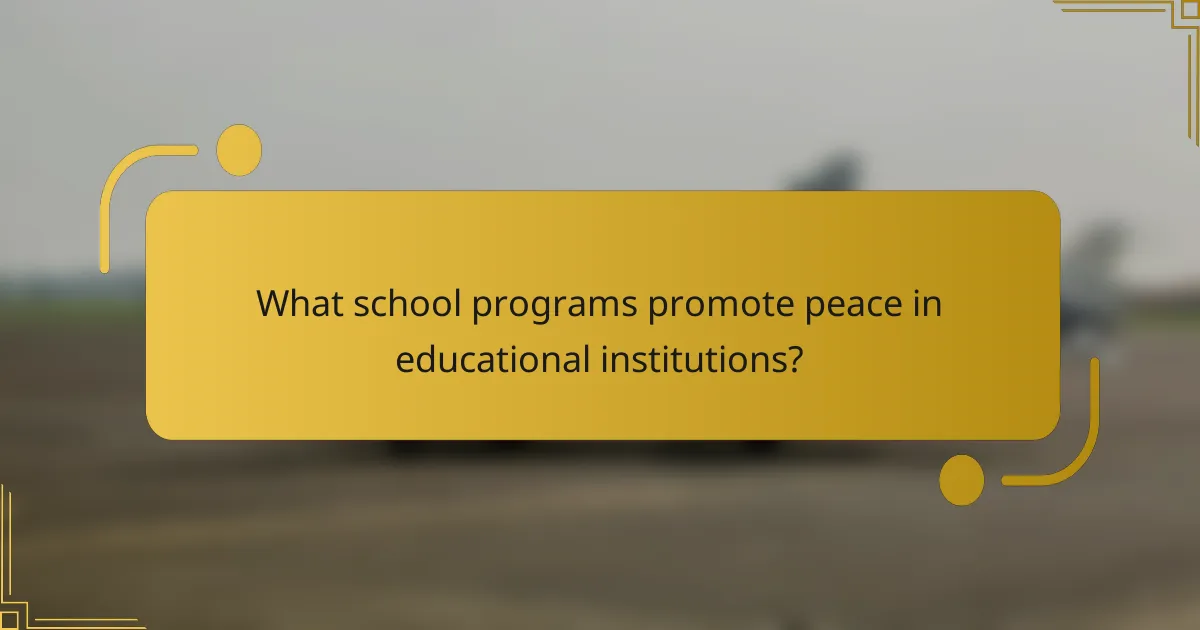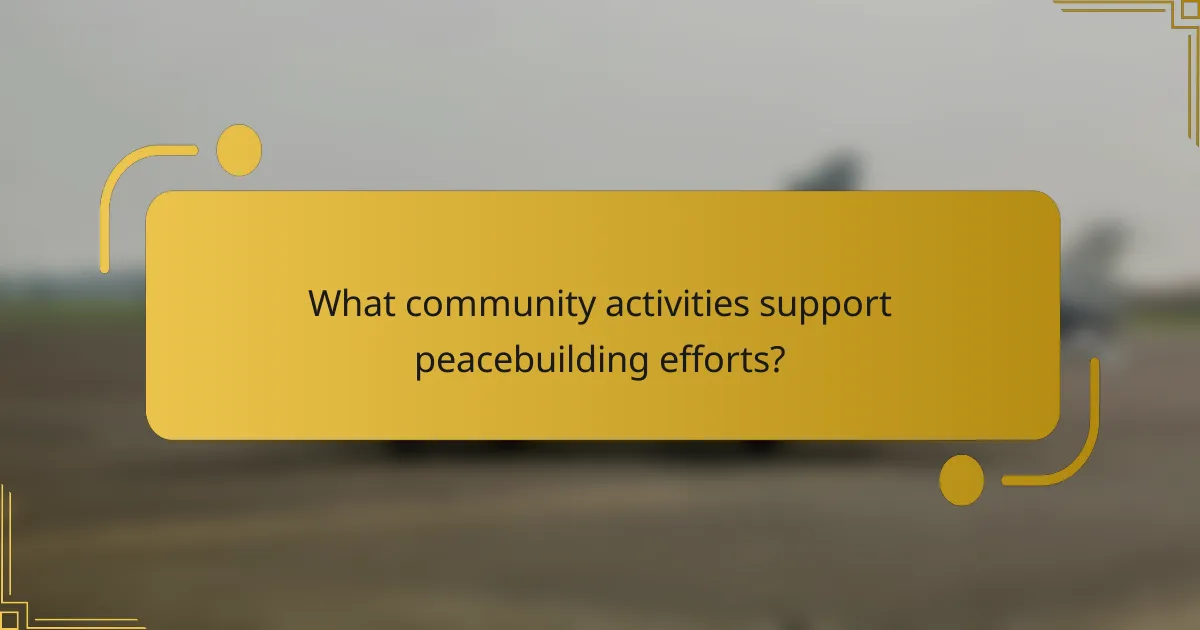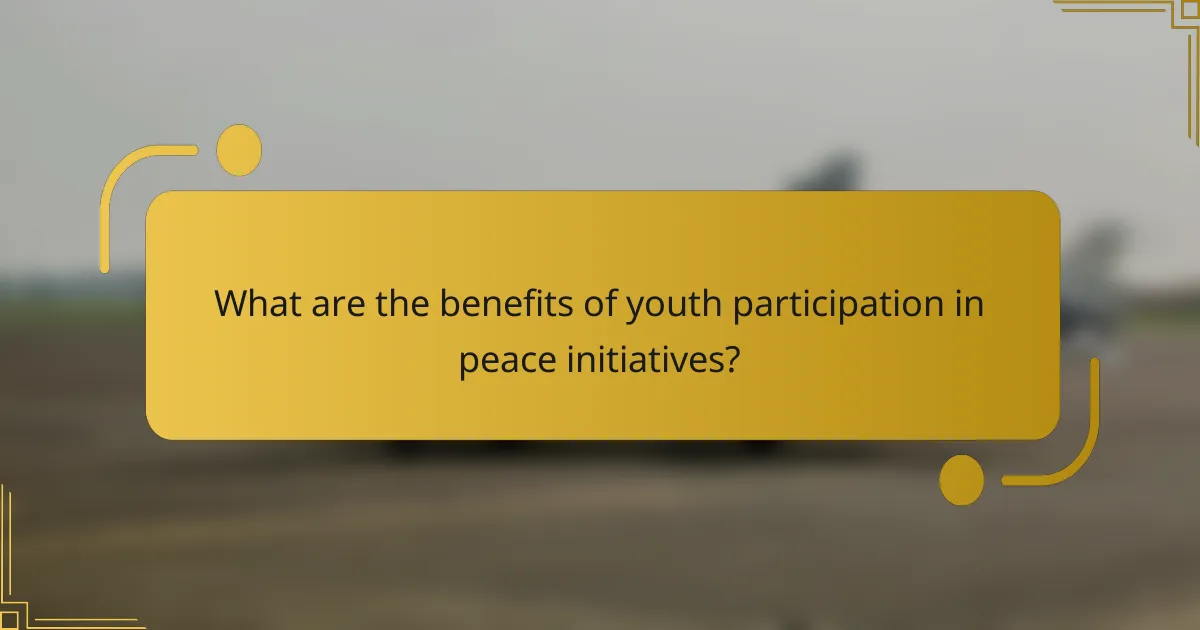Engaging youth in peace initiatives is crucial for fostering a culture of understanding and collaboration within communities. Through school programs that emphasize conflict resolution and emotional intelligence, students learn essential skills that contribute to a positive environment. Additionally, community activities that bring together diverse groups help promote harmony and celebrate differences, further enhancing peacebuilding efforts.

How can youth engage in peace initiatives in the United States?
Youth in the United States can engage in peace initiatives through various avenues that promote community involvement, conflict resolution, and advocacy. By participating in these activities, young people can contribute to building a more peaceful society while developing valuable skills.
Community service projects
Community service projects allow youth to actively contribute to their neighborhoods while fostering a sense of responsibility and teamwork. These projects can include organizing clean-up days, volunteering at local shelters, or participating in food drives.
To get involved, youth can connect with local nonprofits or schools to identify ongoing initiatives. It’s beneficial to choose projects that resonate with personal interests, as this can enhance motivation and commitment.
Peer mediation programs
Peer mediation programs empower youth to resolve conflicts among their peers constructively. In these programs, trained students facilitate discussions between conflicting parties, helping them find mutually agreeable solutions.
Schools can implement these programs by training interested students in mediation techniques. Successful peer mediation can reduce bullying and improve school climate, making it essential for students to understand the importance of effective communication and empathy.
Youth-led advocacy campaigns
Youth-led advocacy campaigns enable young people to raise awareness about social issues and influence policy changes. These campaigns can focus on topics such as mental health, environmental protection, or gun violence prevention.
To launch a campaign, youth should identify a specific issue, gather support from peers, and utilize social media to amplify their message. Engaging with local leaders and participating in community forums can also enhance the campaign’s impact and visibility.

What school programs promote peace in educational institutions?
School programs that promote peace focus on fostering a positive environment where students learn to resolve conflicts, develop emotional intelligence, and engage in restorative practices. These initiatives help create a culture of respect and understanding, which is essential for effective learning and community building.
Social-emotional learning curricula
Social-emotional learning (SEL) curricula are designed to teach students skills such as self-awareness, empathy, and relationship management. These programs typically include interactive activities, discussions, and role-playing scenarios that encourage students to understand their emotions and those of others.
Implementing SEL can lead to improved academic performance and reduced behavioral issues. Schools may adopt frameworks like CASEL (Collaborative for Academic, Social, and Emotional Learning) to structure their SEL programs effectively.
Conflict resolution workshops
Conflict resolution workshops equip students with strategies to address disagreements constructively. These workshops often involve simulations and guided discussions that help participants practice negotiation and mediation techniques.
Schools can host these workshops periodically, allowing students to learn and apply conflict resolution skills in real-life situations. Engaging trained facilitators can enhance the effectiveness of these sessions, ensuring that students gain practical tools for managing conflicts peacefully.
Restorative justice practices
Restorative justice practices focus on repairing harm and restoring relationships rather than simply punishing offenders. This approach encourages open dialogue between affected parties, fostering accountability and understanding.
Schools implementing restorative justice may hold circles or conferences where students can express their feelings and work collaboratively toward resolution. This method not only addresses the immediate conflict but also promotes a supportive school community that values empathy and reconciliation.

What community activities support peacebuilding efforts?
Community activities that support peacebuilding efforts foster understanding, collaboration, and harmony among diverse groups. These initiatives often involve local residents coming together to address conflicts, celebrate diversity, and promote peaceful coexistence.
Neighborhood peace festivals
Neighborhood peace festivals are events designed to celebrate cultural diversity and promote unity within communities. These festivals typically feature music, food, art, and activities that encourage interaction among residents from different backgrounds.
Organizing a peace festival involves collaboration with local organizations, schools, and businesses. It’s important to create a welcoming atmosphere where everyone feels included, which can help reduce tensions and build lasting relationships.
Interfaith dialogue events
Interfaith dialogue events bring together individuals from various religious backgrounds to discuss shared values and address misunderstandings. These gatherings can take the form of workshops, panel discussions, or informal meet-ups, focusing on common goals like peace and community service.
Successful interfaith events require careful planning, including selecting a neutral venue and inviting representatives from different faiths. Encouraging open communication and respect for differing beliefs is crucial to fostering a constructive dialogue.
Local peace committees
Local peace committees consist of community members who work collaboratively to identify and resolve conflicts. These committees often include representatives from various sectors, such as education, law enforcement, and social services, ensuring a comprehensive approach to peacebuilding.
Establishing a peace committee involves recruiting committed individuals and defining clear objectives. Regular meetings and community outreach initiatives can help maintain momentum and engage a broader audience in peace efforts.

What are the benefits of youth participation in peace initiatives?
Youth participation in peace initiatives fosters personal growth and strengthens community ties. Engaging young people in these programs cultivates skills that are essential for effective leadership and promotes a culture of understanding and collaboration.
Development of leadership skills
Participating in peace initiatives helps youth develop crucial leadership skills such as communication, decision-making, and conflict resolution. These programs often provide opportunities for young people to take on roles that require them to organize events, facilitate discussions, or lead community projects.
For example, a youth-led workshop on conflict resolution can empower participants to express their views and negotiate solutions, enhancing their confidence and ability to lead in various contexts. Schools and community organizations can support this by offering training sessions or mentorship programs.
Increased community cohesion
Youth involvement in peace initiatives can significantly enhance community cohesion by bridging gaps between diverse groups. When young people collaborate on projects, they foster connections and understanding among peers from different backgrounds.
Community activities, such as intergenerational dialogues or cultural exchanges, can create shared experiences that build trust and solidarity. Local governments and NGOs can facilitate these interactions by organizing inclusive events that encourage participation from all community segments.
Enhanced empathy and understanding
Engaging in peace initiatives allows youth to develop empathy and a deeper understanding of others’ perspectives. Through discussions and collaborative activities, they learn to appreciate different viewpoints and the complexities of conflict.
Programs that include storytelling or role-playing exercises can be particularly effective in promoting empathy. By stepping into someone else’s shoes, young participants can better grasp the emotional and social factors that contribute to conflicts, leading to more compassionate responses in real-life situations.

How do organizations measure the impact of peace programs?
Organizations measure the impact of peace programs through various methods that assess both qualitative and quantitative outcomes. These evaluations help determine the effectiveness of initiatives aimed at fostering peace among youth, schools, and communities.
Surveys and feedback forms
Surveys and feedback forms are essential tools for gathering direct input from participants in peace programs. They can include questions about personal experiences, perceived changes in attitudes, and overall satisfaction with the program. Organizations often use a mix of open-ended and closed questions to capture both qualitative insights and quantitative data.
To ensure effective feedback collection, organizations should keep surveys concise and focused, ideally taking no more than 10-15 minutes to complete. Offering incentives, such as small rewards or recognition, can also encourage higher response rates.
Community engagement metrics
Community engagement metrics provide insights into how well peace initiatives resonate within the local community. These metrics can include attendance at events, participation levels in activities, and the number of partnerships formed with local organizations. Tracking these indicators helps organizations gauge community interest and support for peace initiatives.
For effective measurement, organizations should establish clear benchmarks for success, such as aiming for a specific percentage increase in community participation over time. Regularly reviewing engagement data allows for adjustments to programs, ensuring they remain relevant and impactful.


